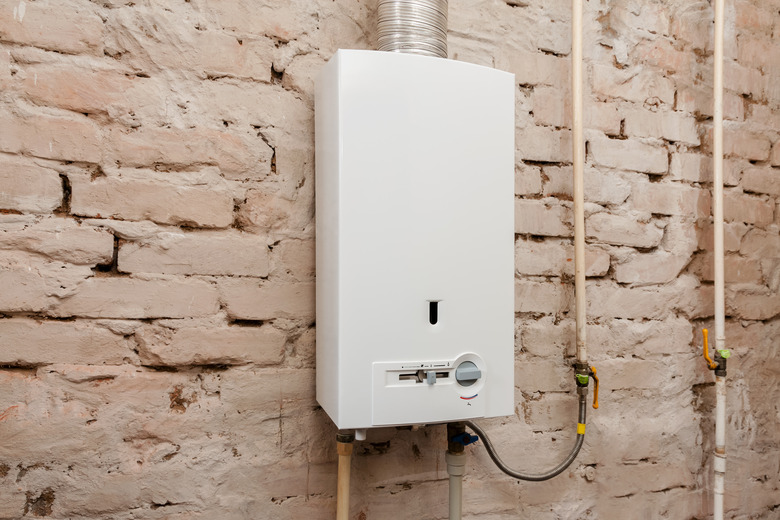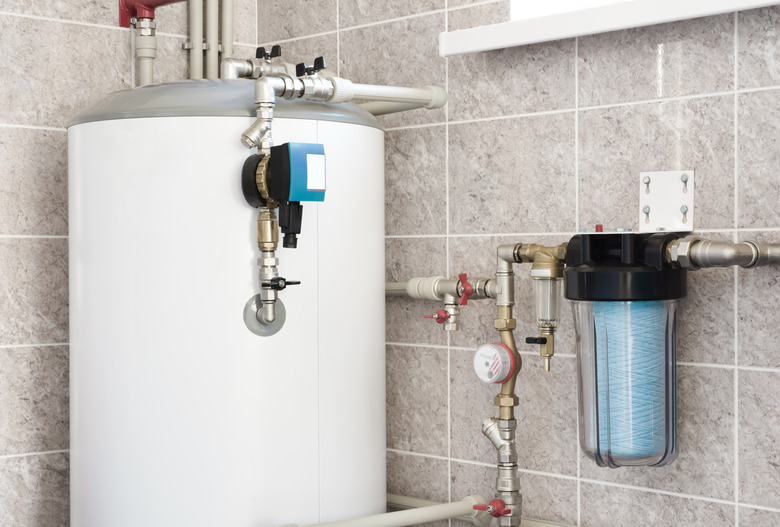A Homeowner's Guide To Maintaining A Boiler Heating System
We may receive a commission on purchases made from links.
All the pipes, pressure gauges, valves and system controls can make boiler maintenance look more complicated and intimidating than it actually is, and although most serious problems with a boiler system need professional attention, a homeowner can and should take care of routine maintenance. A boiler needs monthly and even daily inspections that are easy to do and help guard against a system failure — which, as a corollary of Murphy's Law states, always happens at the least convenient time.
A home heating system with a boiler typically has radiators, baseboard heaters or in-floor radiant heat but not always. Some homes have forced-air boiler systems, which are designed somewhat like heat pumps. In a forced-air boiler system, water heated by the boiler circulates in coils in the air handler, and the heat that radiates from the coils is circulated throughout the ductwork system by a blower. The boilers for all systems, including radiators, baseboard heaters, in-floor heat and forced-air radiant heat, operate in more or less this same way, although there are variations depending on the type of fuel.
To give your system the TLC it needs, it helps to understand how it works, and the best way to do that is to read your owner's manual. All you really need to help you do routine boiler maintenance and pinpoint problems that need boiler service, however, is a general idea of the principles of boiler operation.
Different Types of Boilers
Different Types of Boilers
Boilers have been around for a long time, and some older homes have antiquated ones with heavy cast iron tanks that circulate steam, although these get low marks when it comes to energy efficiency and are gradually being replaced. Modern boilers work on the same principle as on-demand water heaters, with a series of coils positioned next to the heat source, where they can absorb heat. The heat is produced by the combustion of natural gas, propane or heating oil or by resistive electric elements. When combustion occurs, it does so in a sealed combustion chamber that has to be vented outdoors to exhaust combustion gases, and heat passes to the coils through a heat exchanger that is part of the enclosure.
Steam boilers have to heat water to the boiling point, and the steam rises by convection to the highest point in the system, where it condenses and falls back to the boiler as water. These gravity systems were common in the early 20th century, but they are less efficient than contemporary hot water systems, which only have to raise the water temperature to a range between 150 and 190 degrees Fahrenheit rather than the 212 degrees needed to boil water. Some of the energy savings are eaten up by a circulation pump, however, and keeping it in good working order is vital for system operation.
Like high-efficiency gas furnaces, many contemporary gas boilers have a secondary heat exchanger that condenses the exhaust gases to extract heat. The combustion gases that emerge from the primary heat exchanger enter a secondary heat exchanger (a series of small tubes) where the gases cool and condense into acidic water. Condensation is a process that releases heat, and that extra heat is passed to the water instead of being lost to the atmosphere. The remaining exhaust gases are cool and need to be vented by a PVC pipe, which — unlike the metal flue on a noncondensing model — is not subject to corrosion. This type of boiler also needs a drain to remove condensate, and it may have to be cleaned periodically.
Monitor the Pressure Gauges
Monitor the Pressure Gauges
By itself, a gas boiler looks and works like a gas furnace, but unlike a forced-air heating system, a boiler system has one or more pressure gauges to monitor the internal water pressure. There is usually one on the boiler itself, and if the system has separate zones, there may be a manifold (or a central hub) in the boiler room with a valve and a pressure gauge for each zone. The correct boiler pressure is typically 10 to 14 PSI when the system is cold and 20 to 30 PSI when it's hot.
Monitoring the pressure is an important daily task for any homeowner with a boiler system because the system won't heat if the pressure is too low and could spring a catastrophic leak if the pressure is too high, although most systems have a pressure-release valve to prevent this. If the pressure is habitually high, this valve will frequently release water, which will spill onto the floor, and if you notice this, you should call a licensed boiler repair technician.
A low-pressure situation is usually caused by a low water level in the system. Most contemporary systems have an automatic fill valve, and if it isn't working, fixing it is a job for an HVAC pro. If the system has manual fill valves (there are usually two of them), use this procedure to raise the pressure:
- Turn off the system and wait for it to cool down.
- Open one of the valves all the way. Then, open the second slowly and watch the needle on the pressure gauge.
- Wait for the needle to come into the green zone, which begins between 10 and 12 PSI. Allow it to move to the center of the zone, but if it stops at the beginning and won't go any farther, that's fine. It just means the system has a pressure reducer.
- Immediately close the first valve and then close the second one.
Dealing With Air Locks
Dealing With Air Locks
Because the pipes connected to a boiler form a closed system, any air that gets in can't get out and forms bubbles that prevent water from circulating. A common symptom of this problem is a baseboard heater or radiator in one part of the house that won't get hot while the rest of the system operates normally. If you have a combi-boiler that serves to heat water for use in the kitchen and bathroom as well as for the heating system, you may find that because of an air lock, you don't have enough hot water for a shower.
If your baseboard heaters or radiators have bleed valves, you can often release an air lock by opening each valve in turn, beginning with the one on the heating element that won't get hot. This should be done while the system is on and the thermostat is turned up so the water is hot; wear rubber gloves and goggles to protect yourself. You may need a special key to open some bleed valves, but you can open most with a screwdriver or socket wrench. Hold a bowl under the valve to catch water and leave the valve open until all hissing and spurts have stopped and there's only a steady stream of water.
You can also purge air by partially draining the boiler, which should be done with the boiler off and the water cool. Attach a hose to the drain valve and run the other end of the hose to a suitable drain. Shut off the return valve to stop water from flowing back into the boiler and open the drain valve. If the system has an automatic fill valve, it will refill the boiler as water is draining, but if you have a manual valve, you have to remember to open it. When air stops spurting from the hose and there's only a steady stream of water, close the drain valve, open the return valve and check the water pressure. If it's below 12 PSI, open the fill valve to increase the pressure.
Routine Boiler Maintenance Checklist
Routine Boiler Maintenance Checklist
Not everyone has the time to inspect the boiler every day, but the more often you do it, the sooner you'll be able to diagnose small problems that could end up being bigger ones in the near future. A routine inspection and maintenance checklist should include the following items:
- Check the floor around the boiler for water. This could mean the pressure relief valve is spraying water, and if so, you should also see water around the valve. Water on the floor could also mean the condensate drain of your high-efficiency gas boiler is blocked. If so, you can usually clear the drain by sucking out the blockage from outside using a wet/dry vacuum.
- Check the pressure and temperature gauges. If they aren't in the proper range, you may be able to fix it yourself by using the fill valve, for example. If the pressure is too high, try draining the expansion tank, which is a beach-ball-sized water tank mounted near the boiler on a separate run of pipe. To drain it, first attach a hose and wait for the system to cool. Then, attach a hose to the drain valve, open the valve and leave it open until water stops flowing out.
- Inspect the flames in the combustion chamber while the boiler is on. They should be a uniform bluish color. If you see streaks of orange, call for boiler service because it might mean the heat exchanger is cracked and releasing carbon monoxide into the boiler room. This is a dangerous situation. Turn off the boiler and leave it off until a service pro inspects it.
- Note any error codes on the boiler control panel. Write down any you see and look them up in the owner's manual or refer to a service pro.
- Check the vents for blockages and buildup and clear any you find. Vents that terminate outside often get blocked by birds, small animals or other debris.
- Listen for strange noises. Pay special attention to components with moving parts, such as the circulation pump, or the blower if you have a forced-air system. Humming or knocking sounds are usually reasons to call for service. Don't try to fix these components yourself or you may void the warranty for the system.
- Clean or replace the air filters if you have a forced-air system with a blower. Dirty filters have a negative effect on air quality, and they reduce the efficiency of the blower, making it work harder and driving up your energy bill.
Boiler Maintenance Includes Regular Tune-Ups
Boiler Maintenance Includes Regular Tune-Ups
A boiler tune-up, which is similar to a furnace tune-up, should be part of an annual maintenance program. Some of the items a professional tune-up includes are:
- Cleaning the gas burners. This helps control soot in the air exchanger, which affects boiler performance.
- Adjusting the thermostat settings and boiler controls to get the most efficient performance from the system.
- Checking all the electrical connections and electrical components.
- Lubricating the circulation pump(s) if applicable.
- Checking the vents and flues for leaks and obstructions and deep cleaning them.
- Testing the condensate drain and cleaning it if necessary.
- Examining the hydronic system for leaks.
A professional tune-up may duplicate some of the maintenance tasks the homeowner should do, but a professional has specialized equipment to do them more thoroughly, and certain maintenance tasks, such as testing and adjusting the controls, can only be done by a pro. Even if you're conscientious about boiler maintenance, it's as important to give it periodic service by a professional as it is for your car, and the cost of routine service is typically much smaller than that of an emergency call.
References
- Modernize: How to Effectively Maintain a Boiler System
- Hometree: Is My Boiler Pressure Too High?
- Energuide.be: How Do I Adjust My Boiler Pressure Properly?
- Petro: Furnace and Boiler Tune Up Benefits and Tips
- American Home Shield: Your Guide to Home Boiler Maintenance
- Mr. Rooter: Is Trouble Boiling? The Homeowner's Guide to Keeping a Boiler in Prime Condition

